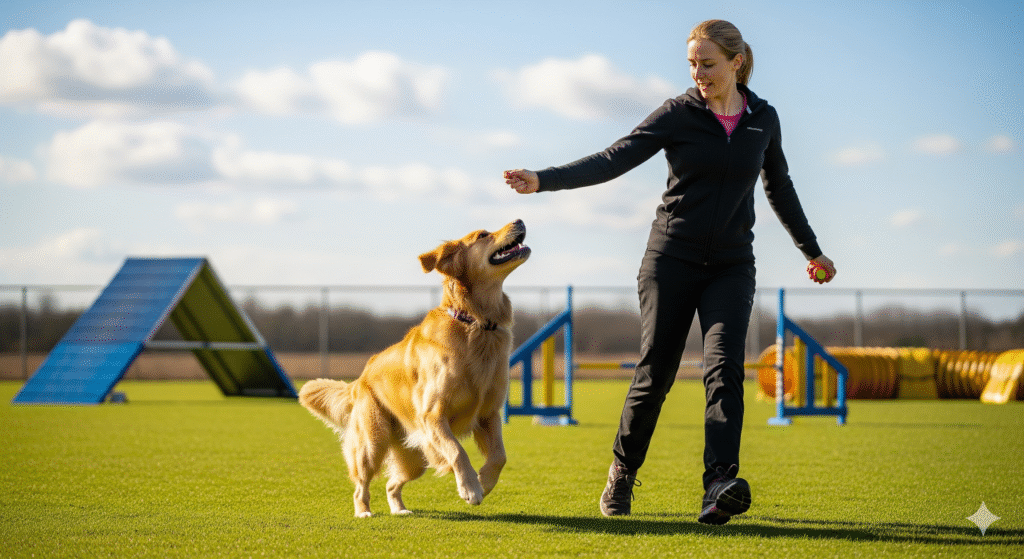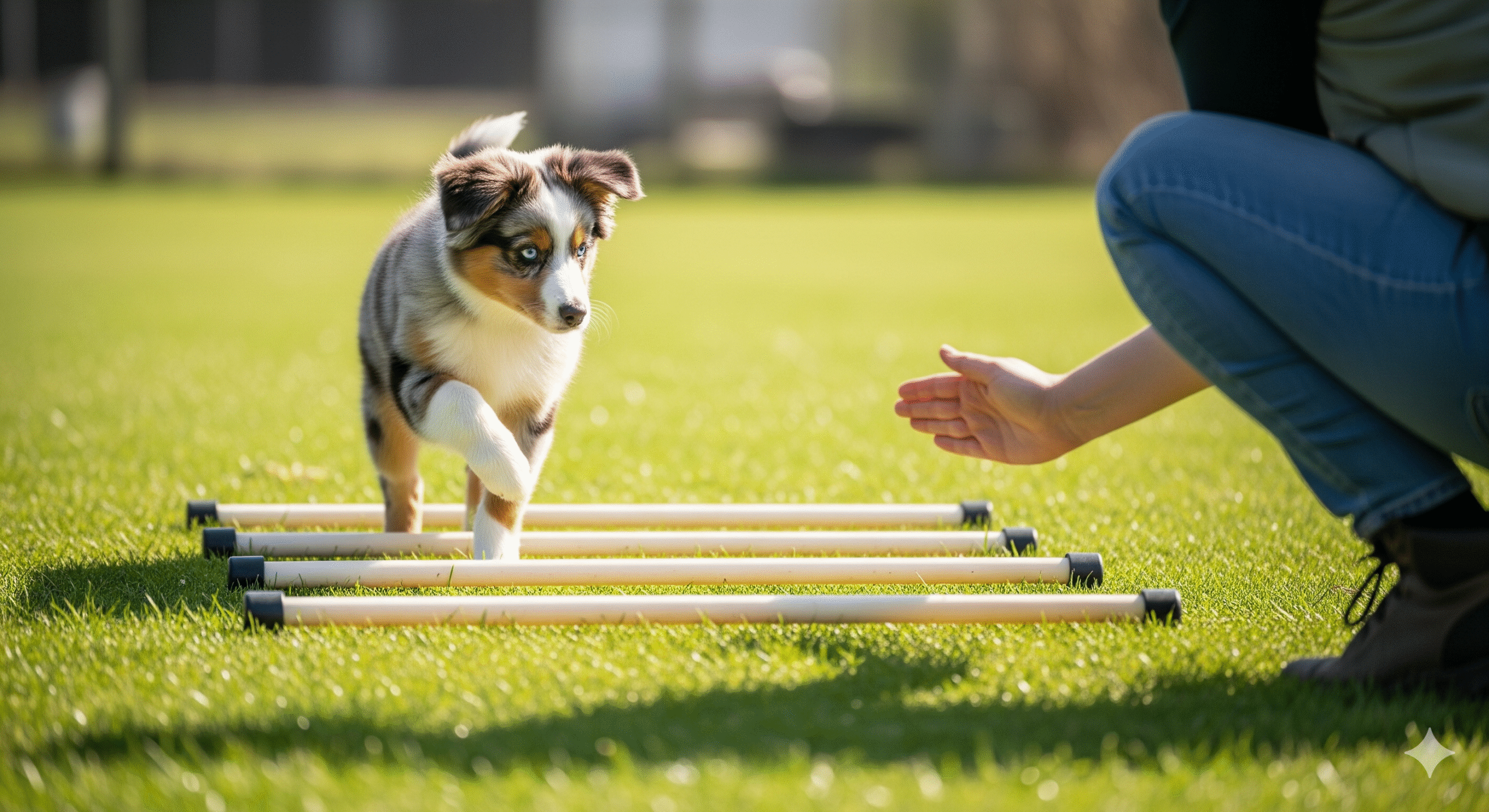The sight of a dog flying through an agility course is a breathtaking display of speed, precision, and teamwork. It’s natural to watch this and dream of doing it with your own puppy. However, true agility training isn’t about teaching a young pup to jump high or weave through poles; it’s about building a rock-solid foundation of confidence, body awareness, and trust that will protect them from injury and set them up for a successful career in the sport. Starting too early or incorrectly can lead to fear, injury, and a ruined love for the game.
This guide is not about competition; it’s about foundation. We’ll focus on safe, age-appropriate exercises that channel your puppy’s energy into skills that will benefit them for life, whether they ever see a formal agility ring or not.
Here’s what we’ll cover:
✔️ Why you must wait to jump—the critical importance of protecting growing joints
✔️ The 4 pillars of puppy agility foundation: confidence, focus, body awareness, and handling
✔️ DIY “agility” equipment you can make at home for $0
✔️ Step-by-step guides for introducing tunnels, wobble boards, and targeting
✔️ Fun games to build focus and engagement
✔️ How to find a positive-reinforcement puppy agility class
Let’s lay the groundwork for a confident, athletic, and happy canine partner.
The Golden Rule: No Jumping! Protecting Growing Joints 🦴
This is the single most important rule for puppy agility. A puppy’s growth plates (the areas of developing cartilage at the ends of long bones) don’t fully close until they are physically mature.
- Small Breeds: ~12-14 months
- Medium Breeds: ~14-16 months
- Large Breeds: ~16-18 months
- Giant Breeds: ~18-24 months
Jumping on hard surfaces or from heights can cause permanent damage to these growth plates, leading to early arthritis and other orthopedic issues.
Your job during puppyhood is to build the brain and the skills, not stress the body.
The 4 Pillars of Puppy Agility Foundation 🏗️
1. Confidence Building 🌟
Agility environments are full of strange, noisy, and moving objects. A confident puppy is a successful puppy.
- Goal: Create a “can-do” attitude where the puppy believes new things are fun and rewarding.
- How: Introduce novel surfaces (bubble wrap, tarps, metal grates), wobble boards, and low, open tunnels in a positive, playful way.
2. Focus & Engagement 👀
In the ring, your dog needs to focus on you despite massive distractions.
- Goal: Teach your puppy that you are the most exciting thing in any environment.
- How: Play engagement games like “Look at That!” (rewarding for checking in with you), hand touch games, and incorporating play with toys as a reward.
3. Body Awareness 🧘♂️
Your puppy needs to learn where their body is in space to navigate equipment safely.
- Goal: Improve proprioception (sense of body position).
- How: Use cavaletti poles (poles on the ground), perch work (standing on a low platform), and encouraging back-up and hind end awareness exercises.
4. Basic Handling Skills 🧭
This is the beginning of teaching your dog how to respond to your movement and position.
- Goal: Introduce the concepts of moving together as a team.
- How: Practice fun, low-pressure recalls, send your puppy around a cone or tree, and practice front crosses (changing sides) without any equipment.
DIY Puppy Agility Equipment: Safe & Cheap 🛠️
You don’t need expensive equipment. You can build a foundation with household items.
- Cavaletti Poles: Use broom handles or PVC pipes placed on the ground. Have your puppy step over them slowly. Never raise them off the ground.
- Tunnel: Use a large cardboard box with both ends cut out or a pop-up play tunnel for kids. Keep it short and completely open so it’s not scary.
- Wobble Board: Place a small piece of plywood on a tennis ball (cut a small hole to keep it centered). Hold it steady and let your puppy just put paws on it for treats.
- Platform/Perch: A sturdy, low wooden crate or a large, solid book. Teach a “paws up” command.
Step-by-Step: Introducing Foundation Exercises 🎬
1. The Tunnel 🌀
- Completely flatten a pop-up tunnel so it’s just fabric on the ground. Lure your puppy across it with a treat.
- Slowly open it just enough to create a short, open arch. Have a helper hold one end open and lure them through.
- Gradually make the tunnel longer as your puppy gains confidence. Never force them; let them explore at their own pace.
2. Cavaletti Poles (Poles on the Ground) ⚫
- Place one pole on the ground.
- Lure your puppy slowly over it, rewarding for each step.
- Add a second pole a few feet away. The goal is slow, mindful stepping, not speed.
3. Paws Up (Platform Training) 📦
- Use a low, stable surface.
- Lure your puppy’s nose over the platform; as they follow, their front paws will step up.
- Mark and reward the second their paws touch it.
- Eventually add a cue like “paws up” and work on duration (a stay).
4. Hand Touch 👋
- Present your flat palm to your puppy near their nose.
- The second their nose touches your hand, mark (say “yes!”) and reward with the other hand.
- This builds focus and is the foundation for targeting later.
Fun Foundation Games to Play 🎮
- Go Around: Teach your puppy to go around a tree, cone, or chair. This teaches them to work away from you.
- Cookie Sprinkles: Toss a handful of small treats into the grass. This teaches them to use their nose and lowers arousal between exercises.
- Restrained Recalls: Have a helper gently hold your puppy’s collar while you get excited and run away a few steps. Call them and reward hugely when they sprint to you. Builds drive and focus.
Finding a Good Puppy Agility Class 🏫
A good foundation class is invaluable. Look for a trainer who:
- Uses 100% positive reinforcement.
- Does not allow jumping for puppies.
- Focuses on flatwork, confidence, and relationship-building.
- Has equipment appropriate for puppies (low, stable, non-scary).
Run from any class that forces puppies onto tall equipment or uses corrections.
Final Checklist for Getting Started ✅
☑️ My puppy is not jumping on any raised equipment.
☑️ I am focusing on confidence-building with novel surfaces.
☑️ I am practicing engagement games every day.
☑️ I have created some DIY cavaletti poles.
☑️ I am keeping sessions short (3-5 minutes) and fun.

“…Remember, socialization is about more than just meeting other dogs; it’s about exposing your puppy to new environments, sounds, and experiences in a positive way. Once your puppy has mastered basic socialization and obedience, you might start thinking about more advanced activities that can strengthen your bond and provide a job for them to do. If you’re looking for a fun, high-energy team sport, you may want to explore Flyball for Puppies: Is It Right for Yours?.”






